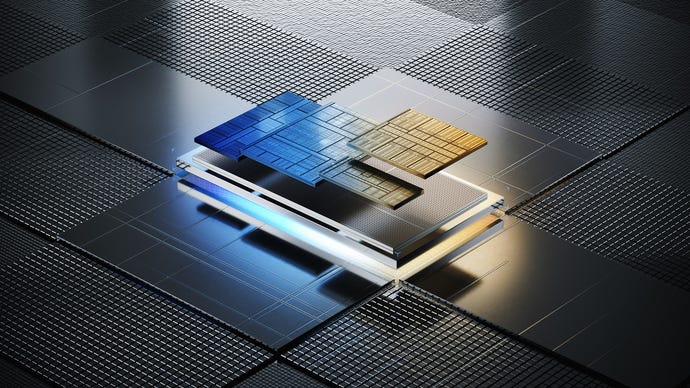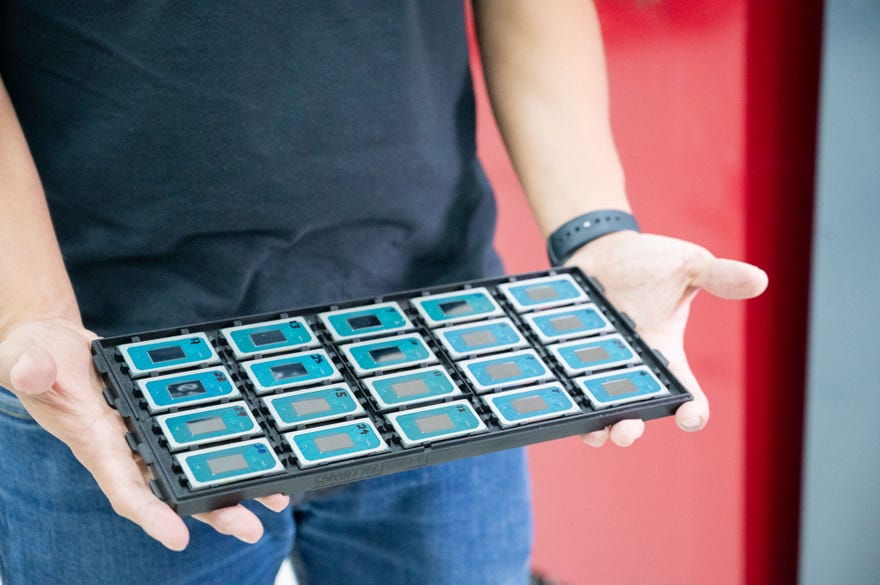Intel Core Ultra laptop CPUs have eyes on AI, but it’s Arc graphics that could change the game
Meteor Lake mobile chips officially detailed
Intel have finally confirmed the full lineup and specs for their 14th gen Meteor Lake CPUs, which for now is comprised entirely of ultrathin laptop chips with the new Core Ultra branding. I appreciate that a PC gaming site might not be the most natural home for this information, considering both that these are not technically gaming CPUs and that that Meteor Lake’s most hyped-up feature is more of a productivity aid: a Neural Processing Unit (NPU) for client-side AI work. However, as the new H-series parts also integrate Intel Arc graphics for the first time, there is some interesting potential for them to transform lightweight ultrabooks into viable gaming laptops.
Why these, and not the countless other integrated GPUs that have made similar promises? The proof will be in the real-world testing pudding, naturally. Still, unlike Intel's innovation-deprived 14th gen desktop CPUs, Raptor Lake Refresh, Meteor Lake represents such a major overhaul of Intel’s existing lappy CPU architecture – with specific changes dedicated to games performance and power efficiency – that they might just pull it off.
The Meteor Lake design is based around four "tiles," with each tile – compute, graphics, SoC, and I/O – dedicated to certain PC duties. The idea is that power can be routed more efficiently to the tiles that are in need, and away from tiles whose functions aren’t in demand at a given moment. The compute tile’s P-core and E-cores (a hybrid design first introduced on the 12th gen Alder Lake CPUs) have also been reworked to sip less juice, while the SoC tile includes two ultra-low-power E-cores that can handle basic, predictable tasks (like video playback) with even less battery drain. Intel reckon that when streaming Netflix, a 14th gen Core Ultra 7 165H uses 25% less power than the 13th gen Core i7-1370P.
As for gaming power, Meteor Lake’s integrated Arc tech is directly begotten of desktop graphics cards like the Arc A750. As such, they’ve got considerably more muscle than the Intel Iris Xe graphics found in 13th gen chips, and perhaps even more significantly, they can employ XeSS upscaling in games that support it. Much like how AMD onboard graphics working with FSR was a big boost to Ryzen CPUs, this newfound XeSS affinity should unlock far higher framerates, and not just on potato settings.

As ever, take manufacturer benchmarks with a wheelie bin of salt, but Intel’s numbers on the Core Ultra 7 165H point to Arc graphics and XeSS being more than just workable for 1080p play. With upscaling and Medium graphics settings, it can supposedly pump out 150fps in Deceive Inc., 80fps in Hitman 3’s Dubai benchmark, 69fps in Like a Dragon: Gaiden, 48fps in The Witcher 3: Wild Hunt, and 36fps in Cyberpunk 2077. If those are repeatable outside of Intel’s labs, they wouldn’t be bad showings at all – they’re better than what you’d get on an Asus ROG Ally, while maintaining a resolution than that of the Steam Deck.
Speaking of which, I do wonder if the gaming accomplishments of handheld PC chips have spurred on Intel (and, indeed, AMD) to upgrade their integrated graphics. If Meteor Lake can make look-ma-no-graphics-card gaming more appealing, great! But it’s evidently not a new concept, and the Steam Deck in particular has been providing an excellent alternative to bulky gaming laptops for the better part of two years now. While Intel aren’t currently making APUs for the future Deck rivals – or at least, aren’t admitting to it publicly – there’s a whiff of its custom AMD chip, and indeed the ROG Ally/Lenovo Legion Go’s Ryzen Z1 Extreme, in the framerate-hunting focus of these new CPUs.
Just a thought, anyway. Here are all the Meteor Lake chips that are launching today, including the U-series CPUs, which don’t have Arc graphics and are thus irrelevant to, uh, half of this article.
| Intel Core Ultra 7 165H | Intel Core Ultra 7 155H | Intel Core Ultra 5 135H | Intel Core Ultra 5 125H | |
|---|---|---|---|---|
| Core/threads | 16/22 | 16/22 | 14/18 | 14/18 |
| P-cores | 6 | 6 | 4 | 4 |
| E-cores | 8 | 8 | 8 | 8 |
| P-core Max Turbo Frequency | 5.0GHz | 4.8GHz | 4.6GHz | 4.5GHz |
| E-core Max Turbo Frequency | 3.8GHz | 3.8GHz | 3.6Ghz | 3.6GHz |
| GPU | Intel Arc GPU | Intel Arc GPU | Intel Arc GPU | Intel Arc GPU |
| Xe cores | 8 | 8 | 7 | 7 |
| Neural processor | Intel AI Boost | Intel AI Boost | Intel AI Boost | Intel AI Boost |
| Base power | 28W | 28W | 28W | 28W |
| Maximum Turbo Power | 115W | 115W | 115W | 115W |
| Intel Core Ultra 7 165U | Intel Core Ultra 7 155U | Intel Core Ultra 5 135U | Intel Core Ultra 5 125U | |
|---|---|---|---|---|
| Core/threads | 12/14 | 12/14 | 12/14 | 12/14 |
| P-cores | 2 | 2 | 2 | 2 |
| E-cores | 8 | 8 | 8 | 8 |
| P-core Max Turbo Frequency | 4.9GHz | 4.8GHz | 4.4GHz | 4.3GHz |
| E-core Max Turbo Frequency | 3.8GHz | 3.8GHz | 3.6Ghz | 3.6GHz |
| GPU | Intel graphics | Intel graphics | Intel graphics | Intel graphics |
| Xe cores | 4 | 4 | 4 | 4 |
| Neural processor | Intel AI Boost | Intel AI Boost | Intel AI Boost | Intel AI Boost |
| Base power | 15W | 15W | 15W | 15W |
| Maximum Turbo Power | 57W | 57W | 57W | 57W |
And here are a few more, planned for launch in something between January and March 2024:
| Intel Core Ultra 9 185H | Intel Core Ultra 7 164U | Intel Core Ultra 5 134U | |
|---|---|---|---|
| Core/threads | 16/22 | 12/14 | 12/14 |
| P-cores | 6 | 2 | 2 |
| E-cores | 8 | 8 | 8 |
| P-core Max Turbo Frequency | 5.1GHz | 4.8GHz | 4.4GHz |
| E-core Max Turbo Frequency | 3.8GHz | 3.8GHz | 3.6Ghz |
| GPU | Intel Arc GPU | Intel graphics | Intel graphics |
| Xe cores | 8 | 4 | 4 |
| Neural processor | Intel AI Boost | Intel AI Boost | Intel AI Boost |
| Base power | 45W | 15W | 15W |
| Maximum Turbo Power | 115W | 30W | 30W |
Processors!









